Lahaina fire survivors test Maui County’s rules on living in the burn zone
This story was originally published by Honolulu Civil Beat. You can sign up for Civil Beat's newsletter here and support the nonprofit newsroom here.
With the trailer on a barge en route to Hawaii, two business partners plan to set up a makeshift home on the now-cleared property.
For three weeks, heaping piles of gravel sat untouched on the dirt lot where Mario Siatris’ house once stood.
The gravel, a form of erosion control, needed to be spread out over the dirt, the final step in an intricate process overseen by the federal government to clear fire-ravaged Lahaina properties of hazards and toxic waste.
Mario’s property had undergone rigorous soil sampling, which revealed that the dirt that hadn’t already been scraped and hauled off to the landfill was clear of contaminants.
With his property deemed safe, he and his business partner U‘i Kahue-Cabanting planned to construct a makeshift shelter on the lot by enclosing a trio of Costco gazebos with plywood. Mario had already assembled a shed to house building tools and materials.
 For weeks Mario Siatris has been monitoring and documenting government-sponsored cleanup activities on his fire-ravaged lot on Mela Street in the heart of Lahaina. (Courtesy: Mario Siatris/2024)
For weeks Mario Siatris has been monitoring and documenting government-sponsored cleanup activities on his fire-ravaged lot on Mela Street in the heart of Lahaina. (Courtesy: Mario Siatris/2024)
But the gravel piles were holding up any further progress. And Mario’s days in government-sponsored emergency housing were numbered.
Mario was supposed to move out of his government-funded condo at the Aston Kaanapali Shores by June 10 as the government worked to end its pricey resort housing program for displaced fire survivors.
U‘i, who had already been kicked out of the Federal Emergency Management Agency’s short-term emergency housing program, was now bunking at Kaanapali Shores with Mario, so if he were to lose his housing, they both would be out of a place to live.
Ultimately, Mario and U‘i plan to live in a 26-foot trailer. But it will be several more weeks until the trailer arrives on Maui from the mainland.
In the meantime, Mario was eager to move out of the resort condominium where he’d lived since shortly after the Aug. 8 fires and start “glamping” on his own property.
But to do that, he needed the gravel to be spread.
“We would have done it ourselves, only it’s freaking hot and it’s three tons of gravel,” U‘i explained.
 Despite the total loss of his century-old plantation house, Mario Siatris says his property in the heart of Lahaina near the old Pioneer Mill smokestack still feels like home. (Courtesy: U‘i Kahue-Cabanting/2024)
Despite the total loss of his century-old plantation house, Mario Siatris says his property in the heart of Lahaina near the old Pioneer Mill smokestack still feels like home. (Courtesy: U‘i Kahue-Cabanting/2024)
The gravel was finally spread at Mario’s property.
And this week, the business partners plan to start constructing their makeshift shelter on Mario’s lot. They had been told they had been given an extension to stay in the government-funded condo but then found out the extension had been revoked.
Luckily, the owner of the condo who learned of their plight offered to put down his own money to cover the fees to keep them housed at Kaanapali Shores through Saturday.
“We’re OK,” U‘i explained. “We’re going to figure this out. But these are 11th-hour decisions, the extending and reneging of contracts, and it’s really stressing everybody out.”
 Mario Siatris plans to construct a makeshift living structure on his Mela Street property. To cope with the lack of working water and sewer lines in his devastated Lahaina neighborhood, he’s hoping to purchase a water buffalo and an on-demand hot water heater, rent a portable toilet and rig up a couple of generators. (Courtesy: U‘i Kahue-Cabanting/2024)
Mario Siatris plans to construct a makeshift living structure on his Mela Street property. To cope with the lack of working water and sewer lines in his devastated Lahaina neighborhood, he’s hoping to purchase a water buffalo and an on-demand hot water heater, rent a portable toilet and rig up a couple of generators. (Courtesy: U‘i Kahue-Cabanting/2024)
Mario and U‘i now have a matter of days to build and move into a makeshift shelter on Mario’s property. On Friday, they plan to rally a group of friends to help them meet the deadline.
Still, the county government has forbidden the owners of property in the burn zone to reinhabit their land just yet. U‘i said she and Mario know what they’re proposing to do will be controversial.
“I’m prepared for somebody of authority to tell us we have to get out,” U‘i said. “And we will say, ‘Why? Is this or is this not our property?’ The soil has been sampled, it’s been cleared, it’s safe. There’s a housing shortage. In fact, there’s zero housing. I am prepared to test the limits, to fight for our rights. And I think Mario is, too.”
The Maui County Council is considering legislation that would allow fire victims to build temporary homes in the burn zone for up to five years. The proposal aims in part to help residents like Mario who don’t have the capital to rebuild a home in today’s market but wish to reoccupy their land as soon as possible.
 Mario Siatris and U‘i Kahue-Cabanting are in the process of shipping a custom-made trailer from California to Maui to serve as a temporary housing solution. The trailer left the port in Oakland, California, on a Matson barge on Wednesday. The $13,000 cost to transport the trailer across the Pacific has been covered by Matson’s community giving program. (Courtesy: U‘i Kahue-Cabanting/2024)
Mario Siatris and U‘i Kahue-Cabanting are in the process of shipping a custom-made trailer from California to Maui to serve as a temporary housing solution. The trailer left the port in Oakland, California, on a Matson barge on Wednesday. The $13,000 cost to transport the trailer across the Pacific has been covered by Matson’s community giving program. (Courtesy: U‘i Kahue-Cabanting/2024)
On Wednesday, the 26-foot custom trailer that Mario and U‘i eventually plan to use as a temporary housing solution set sail from Oakland, California, on a Matson barge. The $13,000 cost to ship the rig across the Pacific is being covered by Matson’s community giving program.
U‘i said it’s difficult to overstate the impact of that kind of savings on her and Mario’s recovery.
“This is about us trying to be self-sufficient as much as we can, finding our own housing solution and moving forward with recovery,” U‘i said. “It’s about Mario getting back to his land.”
Civil Beat’s coverage of Maui County is supported in part by a grant from the Nuestro Futuro Foundation. If you are among the 99% of Civil Beat readers who haven’t made a donation before in support of our independent local journalism, you can change that today. A small donation makes a big impact.



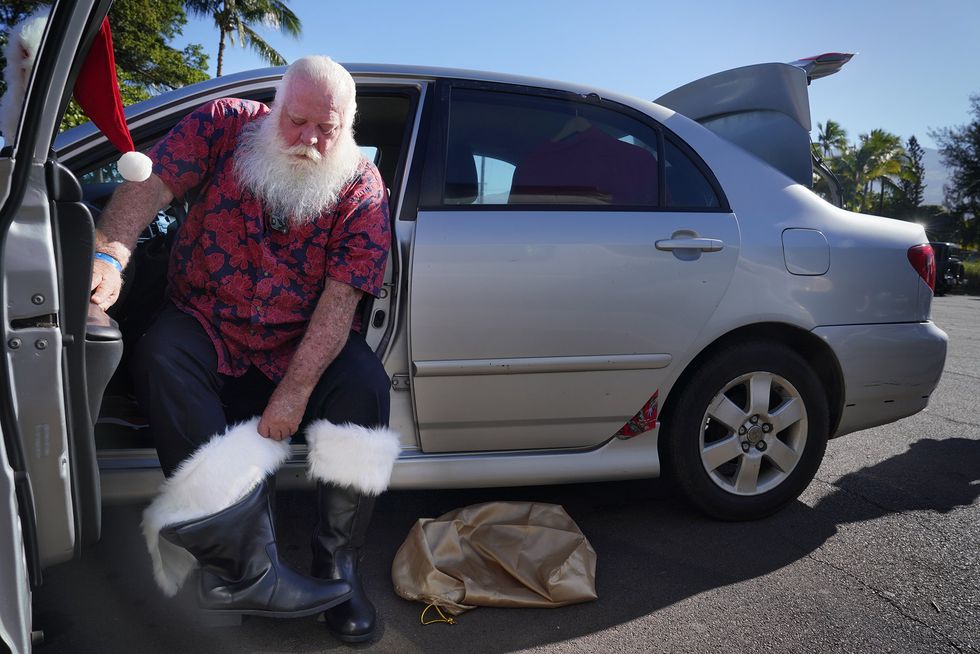 Without a car, Proctor had no way to get to his Santa gigs. But like a Christmas miracle, a Red Cross worker who befriended him in the aftermath of the fire handed him a $1,000 check and told him to rent a car. He contacted a locally owned rental company and the owner cut him a deal: In exchange for a FaceTime call as Santa Claus with her grandchildren, he got a reduced rate on a scratched-up vehicle for the month of December. (Kevin Fujii/Civil Beat/2023)
Without a car, Proctor had no way to get to his Santa gigs. But like a Christmas miracle, a Red Cross worker who befriended him in the aftermath of the fire handed him a $1,000 check and told him to rent a car. He contacted a locally owned rental company and the owner cut him a deal: In exchange for a FaceTime call as Santa Claus with her grandchildren, he got a reduced rate on a scratched-up vehicle for the month of December. (Kevin Fujii/Civil Beat/2023) 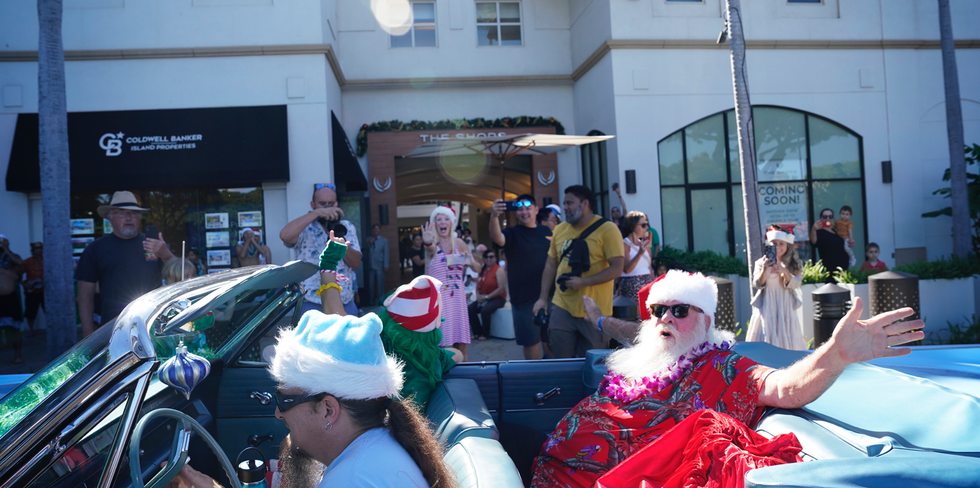 As he returns to his Santa Claus duties on Black Friday, Proctor waves from his ride at The Shops at Wailea. Santa was the grand marshal of the Santa Parade. He rode in style in a 1936 Oldsmobile with the Maui Classic Cruisers and Street Bikers United Hawaii. (Kevin Fujii/Civil Beat/2023)
As he returns to his Santa Claus duties on Black Friday, Proctor waves from his ride at The Shops at Wailea. Santa was the grand marshal of the Santa Parade. He rode in style in a 1936 Oldsmobile with the Maui Classic Cruisers and Street Bikers United Hawaii. (Kevin Fujii/Civil Beat/2023) Proctor as Santa reads a book to passengers aboard the Alii Nui Santa cruise. One of the most difficult parts of the job is wearing a traditional velvet and fur Santa suit in tropical weather. Occasionally he’ll work a gig that calls for him to dress more comfortably in a festive aloha shirt as tropical Santa. (Kevin Fujii/Civil Beat/2023)
Proctor as Santa reads a book to passengers aboard the Alii Nui Santa cruise. One of the most difficult parts of the job is wearing a traditional velvet and fur Santa suit in tropical weather. Occasionally he’ll work a gig that calls for him to dress more comfortably in a festive aloha shirt as tropical Santa. (Kevin Fujii/Civil Beat/2023) 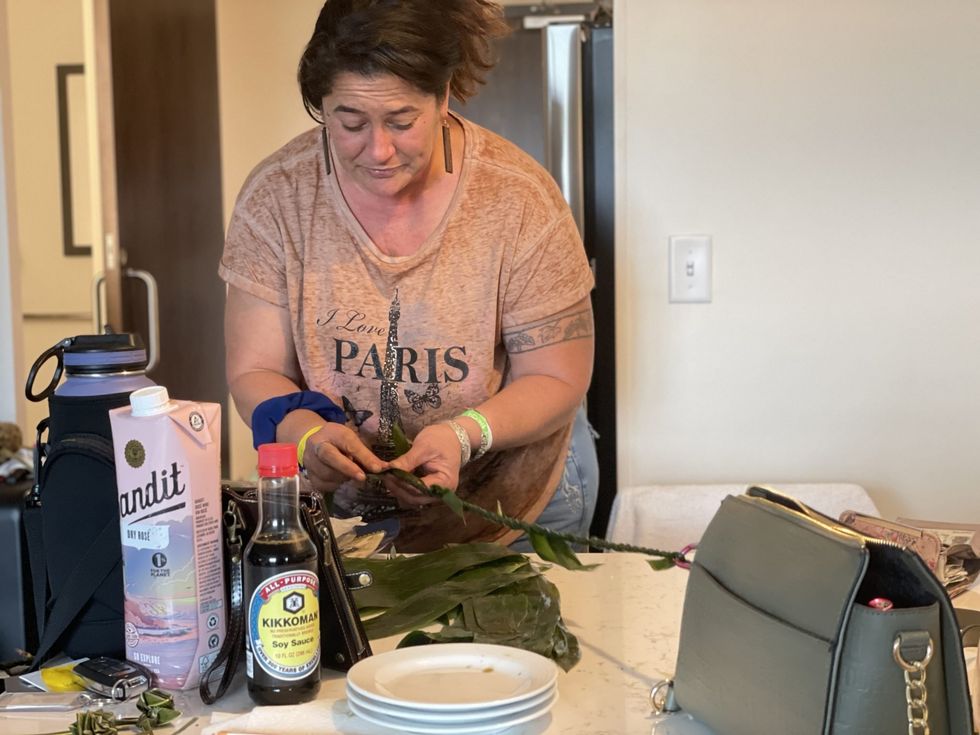 U‘i Kahue-Cabanting weaves a ti leaf lei in her Oregon hotel room as she talks on speaker phone with an American Red Cross worker, who, seven weeks after the fire, is still trying to verify her as a genuine Lahaina fire survivor. Brittany Lyte / Honolulu Civil Beat
U‘i Kahue-Cabanting weaves a ti leaf lei in her Oregon hotel room as she talks on speaker phone with an American Red Cross worker, who, seven weeks after the fire, is still trying to verify her as a genuine Lahaina fire survivor. Brittany Lyte / Honolulu Civil Beat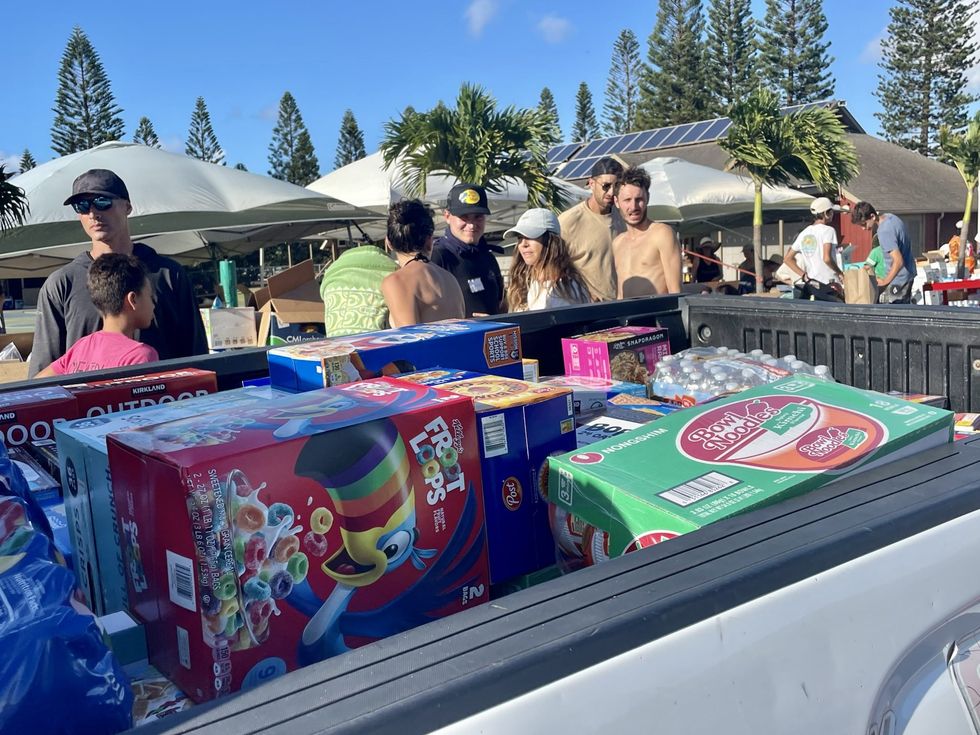 Donations have poured in to Maui Preparatory Academy, a supplies distribution center in Lahaina. But volunteers worry residents who need supplies don’t know where to go for assistance amid a communications blackout. Photo: Brittany Lyte/Civil Beat/2023
Donations have poured in to Maui Preparatory Academy, a supplies distribution center in Lahaina. But volunteers worry residents who need supplies don’t know where to go for assistance amid a communications blackout. Photo: Brittany Lyte/Civil Beat/2023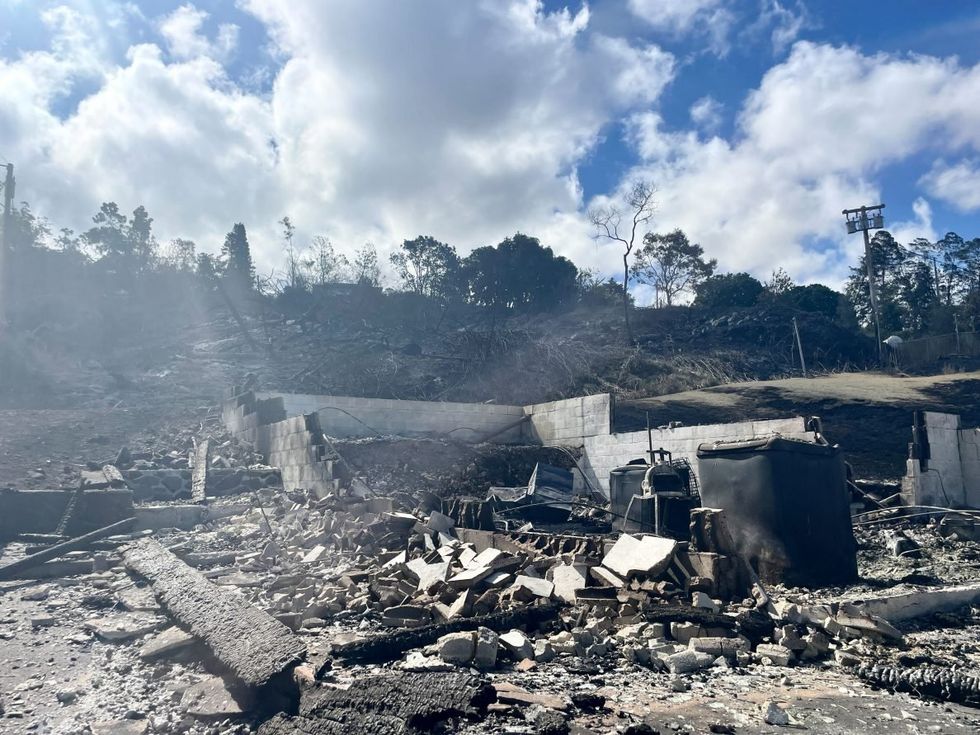 Wildfire destroyed an historic redwood home at Kula Sandalwoods Cafe and Inn in Upcountry. Photo: Brittany Lyte/Civil Beat/2023
Wildfire destroyed an historic redwood home at Kula Sandalwoods Cafe and Inn in Upcountry. Photo: Brittany Lyte/Civil Beat/2023 Lahaina residents who chose to remain in the fire-scorched region sorted through mountains of clothing donations at Maui Preparatory Academy. Photo: Brittany Lyte/Civil Beat/2023
Lahaina residents who chose to remain in the fire-scorched region sorted through mountains of clothing donations at Maui Preparatory Academy. Photo: Brittany Lyte/Civil Beat/2023